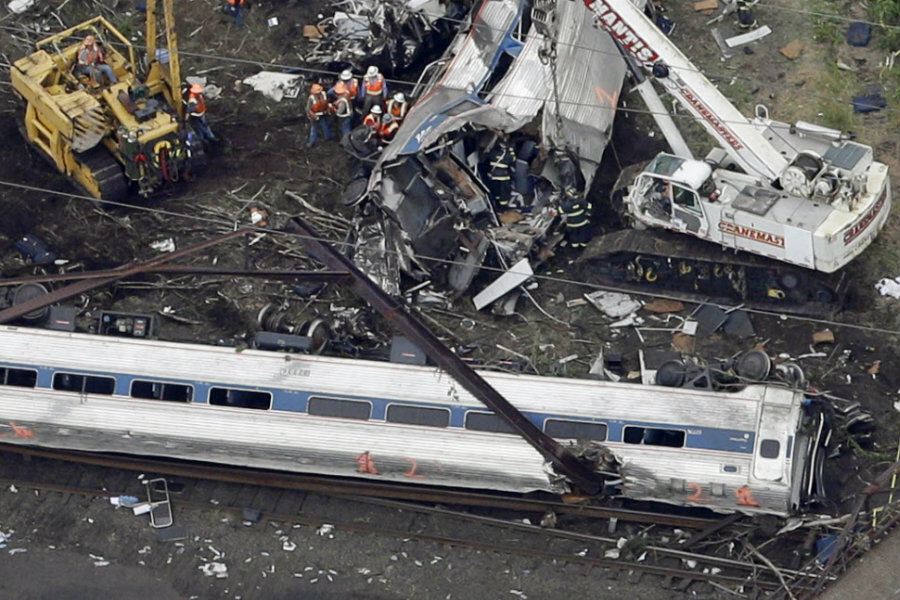Amtrak crash: How safe are America’s railways?
Loading...
On Tuesday, an Amtrak derailment in Philadelphia killed at least seven people and injured hundreds of others.
The accident, still under investigation, has put a spotlight on the ongoing debate about railway funding and safety issues in the United States. Much of the discussion has focused on the rail industry’s progress, or lack thereof, in implementing a 2008 law requiring Positive Train Control (PTC) systems – a set of technologies designed to automatically stop or slow a train before certain types of accidents occur — to be installed in the most heavily traveled lines across the country by the end of this year.
“This [crash] is exactly the type of incident that PTC is designed to prevent,” Deborah Hersman, president of the National Safety Council and former chairman of the National Transportation Safety Board, told NBC News. “So we have seen this before, and we will continue to see it again until PTC is installed."
Yet lawmakers and railroad groups are pushing for an extension of the 2015 deadline, citing the fiscal and technical challenges of equipping the nation’s railways with such sophisticated technologies. Their objections beg the questions: How difficult is it to install PTC tech? What progress has been made since 2008? And, PTC or not, how safe are America’s railways, really?
Passenger train fatalities are rare compared to motor vehicle deaths – though part of the reason is that people most often travel by road, not rail. Still, from 2005 to 2014, only five people died in Amtrak accidents, according to data from the Federal Railroad Association (FRA). In other words, more people were killed in Tuesday’s crash than in the last 10 years.
Commuter rail and Amtrak together total less than 0.5 deaths per billion miles traveled, while cars and trucks number nearly 6 deaths per billion miles, CNN reported.
Technology promises to make America’s railways even safer.
According to the Association of American Railroads (AAR), PTC as mandated by Congress must be designed to prevent, among other things, train-to-train collisions, the movement of a train through a track switch left in the wrong position, and derailments caused by excessive speed – which, based on initial investigations, is what happened in the Philadelphia crash, The Wall Street Journal reported.
PTC monitors multiple data points on every train that passes over a PTC-completed track, according to NBC.
"It tracks the train's speed, weight, braking forces, odometer, distance to advance targets and onboard computers in coordination with enhanced GPS satellite readings to decide whether to alert the engineer of imminent danger or even to take over the brakes automatically," the network reported.
By the end of 2015, the system is supposed to be in place on almost all US rails through which passengers or hazardous materials travel: A total of about 22,500 locomotives on tens of thousands of miles of track, according to a March 2014 report by the AAR.
But problems abound, beginning with resource constraints. While more than $5 billion has already been spent to improve tracks throughout the US, the AAR and other railroad groups have said the amount is not enough to get the nation’s railways equipped with PTC in time for the deadline.
In its report, the AAR noted that there are too few experts with the knowledge to design and develop different parts of the PTC system. There also aren’t enough firms qualified to build the necessary upgraded signal systems, and thousands of railroad employees still need to be trained to use the new technologies, according to the report.
At the same time, the House Appropriations Committee on Wednesday voted along party lines on a $55 billion transportation and housing bill that would give Amtrak almost a fifth less than its typical $1.4 billion share, and defeated amendments that restore or boost the funding.
Still, there has been some progress.
As of January, half of the required PTC wayside units have been deployed, and a third of the necessary antennae have been installed, the AAR reported. Close to 2,500 railroad signal personnel have been hired, and 60 percent of the required locomotives have been fully or partially equipped with PTC.
But as Tuesday’s crash shows, “There is clearly more that can be done when we're talking about a railway infrastructure that is decades-old," White House spokesman Josh Earnest told CNN Wednesday. "If there's an opportunity for us to make further investments in our infrastructure that would better safeguard the traveling public, then those are investments that we should make."








